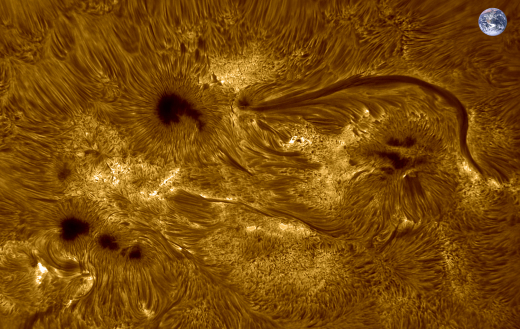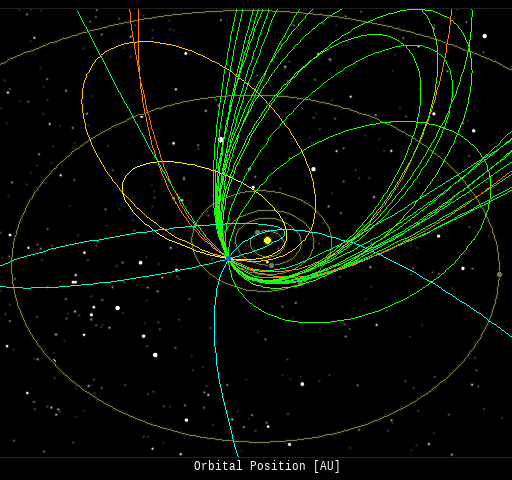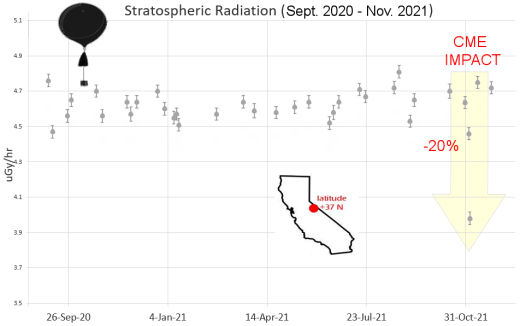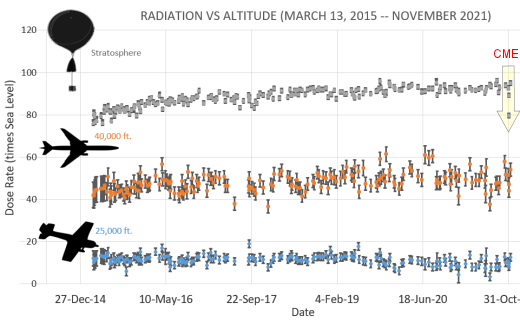 | | | Switch to: Europe, USA, New Zealand, Antarctica Credit: NOAA/Ovation  Planetary K-index Planetary K-index
Now: Kp= 2 quiet
24-hr max: Kp= 4 unsettled
explanation | more data
Interplanetary Mag. Field
Btotal: 5.02 nT
Bz: 3.73 nT north
more data: ACE, DSCOVR
Updated: Today at 1145 UT  Coronal Holes: 23 Apr 22 Coronal Holes: 23 Apr 22 
There are no significant coronal holes on the Earthside of the sun. Credit: SDO/AIA  Noctilucent Clouds Noctilucent Clouds
The southern season for noctilucent clouds is over. It ended on Feb. 20, 2022, concluding the weakest NLC season in 14 years. The northern season will begin in late May.. Switch view: Ross Ice Shelf, Antarctic Peninsula, East Antarctica, Polar Updated at:  SPACE WEATHER
NOAA Forecasts | | Updated at: 2022 Apr 23 2200 UTC FLARE | 0-24 hr | 24-48 hr | CLASS M | 40 % | 40 % | CLASS X | 10 % | 10 % |  Geomagnetic Storms: Geomagnetic Storms:
Probabilities for significant disturbances in Earth's magnetic field are given for three activity levels: active, minor storm, severe storm Updated at: 2022 Apr 23 2200 UTC Mid-latitudes | 0-24 hr | 24-48 hr | ACTIVE | 20 % | 15 % | MINOR | 05 % | 05 % | SEVERE | 01 % | 01 % | High latitudes | 0-24 hr | 24-48 hr | ACTIVE | 15 % | 15 % | MINOR | 25 % | 25 % | SEVERE | 30 % | 25 % | | | |  | | | | | | | | | | | Never miss another geomagnetic storm. Sign up for Space Weather Alerts and you'll receive a text message when magnetic storms erupt. Aurora your guides and professional astronomers use this service. You can, too! | | | MORNING PLANETS: Set your alarm for dawn. Jupiter, Venus, Mars and Saturn are lined up beautifully in the morning sky and , soon, Jupiter and Venus will converge for the finest conjunction of 2022. To see the show, all you need is a cup of coffee and some sky maps: April 23, 24, 25, 26, 27, 28, 29, 30, May 1. ANGRY SUNSPOT FACES EARTH: Sunspot complex AR2993-94 is crackling with M-class solar flares and, this weekend, it is directly facing Earth. Philippe Tosi phorographed the active region from Nîmes, France: 
"I inserted an image of Earth for scale," notes Tosai. "It is a big sunspot." Indeed, it is. There are two dark cores as large as Earth, and several more as wide as Earth's Moon. A magnetic filament attached to one of the cores is more than 100,000 km long. These dimensions make the sunspot group an easy target for safely-filtered backyard telescopes. Don't have a filter? Try the projection method, instead. more images: from Michael Karrer of Austria; from Apollo Lasky of Naperville, Illinois; from Günter Kleinschuster of Feldbach, Austria; from Martin Wise of Trenton, Florida; from Maximilian Teodorescu of Magurele, Romania Solar flare alerts: SMS Text Realtime Space Weather Photo Gallery
Free: Spaceweather.com Newsletter
MOTHER'S DAY IS MAY 8TH: Are you looking for an out-of-this world Mother's Day gift? Consider this: Every time the students of Earth to Sky Calculus launch a cosmic ray balloon, they include something extra in the payload--something Mom will love:

Every item in the Earth to Sky Store has flown to the edge of space and comes with a greeting card showing the item in flight. The interior of the card tells the story of the gift's journey from launch to landing. Mom-satisfaction guaranteed! Mother's Day Special: Use coupon code "SPACEMOM" at checkout for a 10% discount. Offer valid from now until Mother's Day (May 8, 2022) . Far Out Gifts: Earth to Sky Store
All sales support hands-on STEM education
Realtime Aurora Photo Gallery
Free: Spaceweather.com Newsletter Every night, a network of NASA all-sky cameras scans the skies above the United States for meteoritic fireballs. Automated software maintained by NASA's Meteoroid Environment Office calculates their orbits, velocity, penetration depth in Earth's atmosphere and many other characteristics. Daily results are presented here on Spaceweather.com. On Apr 23, 2022, the network reported 21 fireballs.
(13 Lyrids, 8 sporadics)  In this diagram of the inner solar system, all of the fireball orbits intersect at a single point--Earth. The orbits are color-coded by velocity, from slow (red) to fast (blue). [Larger image] [movies] Potentially Hazardous Asteroids ( PHAs) are space rocks larger than approximately 100m that can come closer to Earth than 0.05 AU. None of the known PHAs is on a collision course with our planet, although astronomers are finding new ones all the time. On April 23, 2022 there were 2276 potentially hazardous asteroids.
 | Recent & Upcoming Earth-asteroid encounters: | Asteroid | Date(UT) | Miss Distance | Velocity (km/s) | Diameter (m) | | 2020 TQ6 | 2022-Apr-18 | 13.4 LD | 15.4 | 43 | | 2022 GJ4 | 2022-Apr-18 | 3.8 LD | 15.6 | 19 | | 2022 HA | 2022-Apr-18 | 6.9 LD | 11.5 | 48 | | 2022 HH | 2022-Apr-19 | 11.8 LD | 9.9 | 35 | | 2022 HC | 2022-Apr-19 | 3.4 LD | 15.4 | 34 | | 2022 FN3 | 2022-Apr-19 | 15.1 LD | 6.3 | 39 | | 2022 HG | 2022-Apr-19 | 10.8 LD | 7.9 | 51 | | 2022 HB | 2022-Apr-19 | 10.3 LD | 11.6 | 142 | | 2022 HM | 2022-Apr-21 | 0.6 LD | 14.6 | 11 | | 2022 GU3 | 2022-Apr-22 | 4.6 LD | 8.7 | 25 | | 2017 UR2 | 2022-Apr-22 | 19.4 LD | 9.3 | 10 | | 2022 HQ | 2022-Apr-23 | 8.7 LD | 7 | 13 | | 2022 HD | 2022-Apr-24 | 3.7 LD | 7.4 | 13 | | 2020 VN1 | 2022-Apr-25 | 19.3 LD | 2.3 | 9 | | 418135 | 2022-Apr-28 | 8.5 LD | 10.4 | 466 | | 2017 XO2 | 2022-May-01 | 18.8 LD | 12.4 | 125 | | 2017 HG1 | 2022-May-04 | 18.2 LD | 6 | 11 | | 467460 | 2022-May-09 | 14.9 LD | 11.3 | 513 | | 2019 JE | 2022-May-11 | 4.9 LD | 7.2 | 20 | | 2012 UX68 | 2022-May-15 | 2.8 LD | 8.2 | 54 | | 388945 | 2022-May-15 | 15 LD | 8.2 | 290 | | 2013 UX | 2022-May-17 | 16.8 LD | 16.3 | 141 | | 2021 WY | 2022-May-18 | 16.9 LD | 9 | 65 | | 7335 | 2022-May-27 | 10.5 LD | 13.1 | 1058 | | 2021 KO2 | 2022-May-30 | 3.1 LD | 14.8 | 9 | | 2020 DA4 | 2022-Jun-01 | 5.5 LD | 8.9 | 26 | | 2021 GT2 | 2022-Jun-06 | 9.5 LD | 7.5 | 50 | | 2018 LU2 | 2022-Jun-09 | 14.8 LD | 10.7 | 16 | | 2006 XW4 | 2022-Jun-12 | 5.9 LD | 7.3 | 49 | Notes: LD means "Lunar Distance." 1 LD = 384,401 km, the distance between Earth and the Moon. 1 LD also equals 0.00256 AU. MAG is the visual magnitude of the asteroid on the date of closest approach. | | Cosmic Rays in the Atmosphere | SPACE WEATHER BALLOON DATA: Almost once a week, Spaceweather.com and the students of Earth to Sky Calculus fly space weather balloons to the stratosphere over California. These balloons are equipped with sensors that detect secondary cosmic rays, a form of radiation from space that can penetrate all the way down to Earth's surface. Our monitoring program has been underway without interruption for 7 years, resulting in a unique dataset of in situ atmospheric measurements. Latest results (Nov. 2021): Our balloons have just measured a sudden drop in atmospheric radiation. It happened during the strong geomagnetic storms of Nov. 3-4, 2021. Here are the data: 
This is called a "Forbush decrease," named after American physicist Scott Forbush who studied cosmic rays in the early 20th century. It happens when a CME from the sun sweeps past Earth and literally pushes cosmic rays away from our planet. Radiation from deep space that would normally pepper Earth's upper atmosphere is briefly wiped out. We have measured Forbush decreases before. For example, here's one from Sept. 2014. The Forbush Decrease of Nov. 3-4, 2021, was the deepest in the history of our 7-year atmospheric monitoring program. Radiation levels in the stratosphere over California dropped nearly 20%, more than doubling the previous record from our dataset. En route to the stratosphere, our sensors also pass through aviation altitudes, so we can sample radiation where planes fly. This plot shows how the Forbush decrease was restricted to the stratosphere; it did not affect lower levels of the atmosphere: 
The dose rates shown above are expressed as multiples of sea level. For instance, we see that boarding a plane that flies at 25,000 feet exposes passengers to dose rates ~10x higher than sea level. At 40,000 feet, the multiplier is closer to 50x. The higher you fly, the more radiation you will absorb. .Who cares? Cosmic rays are a surprisingly "down to Earth" form of space weather. They can seed clouds, trigger lightning, and penetrate commercial airplanes. According to a study from the Harvard T.H. Chan school of public health, crews of aircraft have higher rates of cancer than the general population. The researchers listed cosmic rays, irregular sleep habits, and chemical contaminants as leading risk factors. Somewhat more controversial studies (#1, #2, #3, #4) link cosmic rays with cardiac arrhythmias and sudden cardiac death. .Technical notes: The radiation sensors onboard our helium balloons detect X-rays and gamma-rays in the energy range 10 keV to 20 MeV. These energies span the range of medical X-ray machines and airport security scanners. Data points in the first graph ("Stratospheric Radiation") correspond to the peak of the Regener-Pfotzer maximum, which lies about 67,000 feet above central California. When cosmic rays crash into Earth's atmosphere, they produce a spray of secondary particles that is most intense at the entrance to the stratosphere. Physicists Eric Regener and Georg Pfotzer discovered the maximum using balloons in the 1930s and it is what we are measuring today. | | The official U.S. government space weather bureau | | | The first place to look for information about sundogs, pillars, rainbows and related phenomena. | | | Researchers call it a "Hubble for the sun." SDO is the most advanced solar observatory ever. | | | 3D views of the sun from NASA's Solar and Terrestrial Relations Observatory | | | Realtime and archival images of the Sun from SOHO. | | | information about sunspots based on the latest NOAA/USAF Active Region Summary | | | from the NOAA Space Environment Center | | | fun to read, but should be taken with a grain of salt! Forecasts looking ahead more than a few days are often wrong. | | | from the NOAA Space Environment Center | | | the underlying science of space weather |  | Going above and beyond to provide the best homes listings in the Comox real estate market to keep you up to date and informed |  | BestCSGOGambling is the best site for everything related to CSGO gambling on the web |  | To find reviews of new online casino sites in the UK try The Casino DB where there are hundreds of online casino reviews complete with bonuses and ratings. Alternatively, Online-Casinos.xyz is another massive directory of online casinos listing sites for the UK and Worldwide. Casinos that offer Rupees for bonuses are very generous to Indian players. Find the best online casinos in India at AllCasinos.in Looking for a new online casino? Try Casimpo the new site dedicated to making online casino simple, or check out the new Avenger Slots Casino and Ace Online Casino with over 500 online slots and casino games. |  | One of the most popular casino games is the Book Of Dead Slot based on ancient Egyptian text, you can find all the casinos with spins at bookofdeadslotsites.com. |  | When looking for casinos to play online when the weather is bad, you can try casino online trucchi for Italian games. If you are not from Finland you can try the Swedish page Svenska casino online to find suitable games, check out svenskacasinoonline.net. Always check your local laws before playing with real money. |  | Looking for sports betting companies not registered on GamStop? CasinoGap has presented a list of sites not on GamStop available for UK players. Check and bet online! Would you like to bet at sites not using GamStop? Look at a list of NonStopCasino sites for online betting that aren't on GamStop. Top-rated bookmakers ever! | | | These links help Spaceweather.com stay online. Thank you to our supporters! | | | | | | | | |  | |  |   | ©2021 Spaceweather.com. All rights reserved. This site is penned daily by Dr. Tony Phillips. | |

